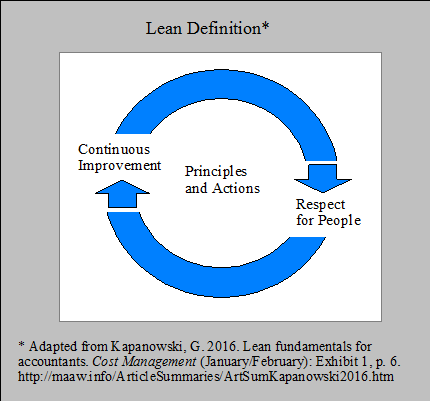
Summary by James R. Martin, Ph.D., CMA
Professor Emeritus, University of South Florida
JIT and Lean Enterprise Main Page |
Lean Accounting Main Page
Lean is a methodology based on the voice of the customer. The purpose of this article is to describe the lean concepts and tools that are used to detect improvements that will add more value to the customer. The guiding principles are respect for people, and continuous improvement involving everyone in the organization.
Lean and Lean Thinking Defined
Kapanowski defines Lean as "the identification, elimination, and reduction of waste or non-value-added activity within a process as perceived by the customer." This includes balancing demand, continuously improving, error proofing, and increasing throughput. Lean thinking was defined by Womack and Jones as "a way to do more and more with less and less - less human effort, less equipment, less time, and less space - while coming closer and closer to providing customers with exactly what they want."1

History of Lean
Kapanowski attributes the beginning of the lean concept to Ford's mass production of automobiles by connecting Ford's system to the development of the Toyota Way (working better, cheaper, easier, faster, and safer) by Taiichi Ohno and Shigeo Shingo. Womack, Jones and Roos coined to term "lean" in their 1991 book The Machine that Changed the World.2
The Benefits of Lean
Implementing lean in an organization provides improvements in the following: Return on assets, on-time delivery, machine availability, machine set-up time, utilization of labor, reduction in floor space, and reduction in inventory.
The Toyota Production System
The Toyota production system includes 14 principles of lean as described by Liker in The Toyota Way 3 and outlined in the illustration below.
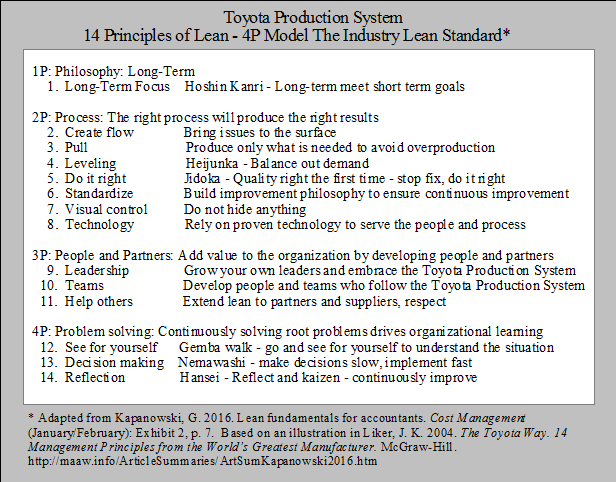
Seven Wastes plus one
Lean focuses on the elimination of muda, or waste categorized in the following illustration using the acronym TIMWOODS.
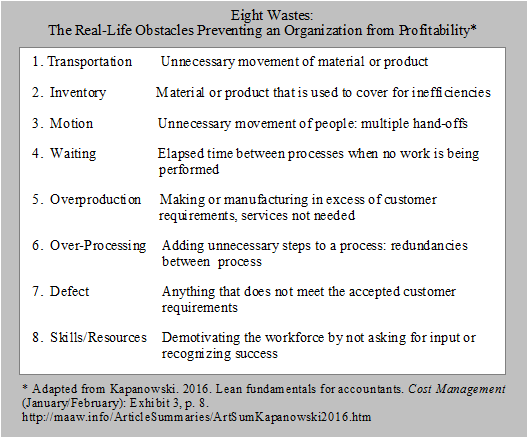
Five Steps in Lean
The five steps involved in maximizing customer value while minimizing waste include:
1. Identify value to the customer in each process. Anything else is waste to be removed.
2. Identify the value stream to understand the entire process.
3. Understand the flow of the process to aid in the reduction of flow time.
4. Establish a pull system, meaning to work on the customer's demand only when needed.
5. Seek perfection with continuous improvement
Lean Manufacturing Roadmap
Kapanowski attributes the basis of lean to W. Edwards Deming's plan-do-check-action (PDCA) continuous improvement cycle4 that was implemented with the Toyota Way. (For some PDCA or PDSA graphics see PDSAGraphic).
Tools and Techniques in the House of Lean
The House of Lean includes a variety of tools and techniques as indicated in the illustration below.
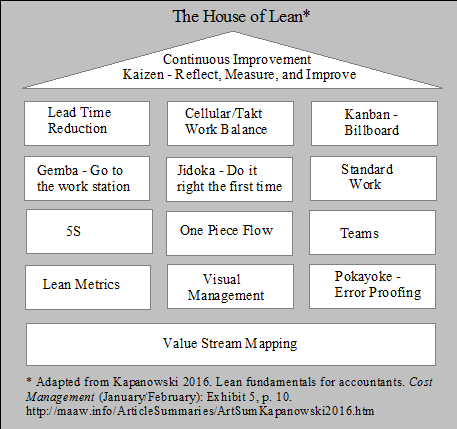
Some of the tools that can be used in a lean office include:
5S - Remove items not needed, and create a system where everything needed has a unique location (seiri), organize the workplace for an orderly flow to eliminate waste (seiton), shine or clean up (seiso), standardize to enforce the rules (seiketsu), and sustain (shitsuke). For example, applying these 5 steps to the Microsoft Excel files used for inventory reconciliation.
Gemba walks - A visual structured data gathering walkthrough of the workplace, e.g., observing the month-end closing process.
Kaizen blitz - A fast structured implementation to improve a process and eliminate waste, e.g., an improvement in cash reconciliation, payroll reporting, or month-end close.
Lead time reduction - The process of identifying and eliminating non-value-added activities or waste from the process to reduce lead time, i.e., time required to process a product or service from customer placing an order to delivery to the satisfied customer.
One piece flow - A pull system concept where each operation is designed so that it can process one item at a time (instead of multiple items) allowing it to meet customer demand as needed.
Run/control charts - A single line chart plotting some value over time to detect trends and significant changes in a process, e.g., days to pay an invoice.
Value stream maps - A graphic documentation of all the activities and information involved in producing a product or service for a customer.
Visual management - Designing the workplace so that it is visually clear when it is effective and efficient.5
Metrics to Drive Performance
Lean metrics include the following:
Classical/traditional yield - total shipped or total attempted to produce measured at the end of the process.
First-time throughput yield - total number of completed parts without rework divided by the total number of parts worked on in a process step.
Rolled throughput yield - Probability of a part being produced through every step in the process without a defect, i.e., without being scrapped or reworked. RTY = (first time yield for process 1)(first time yield for process 2)(first time yield for process N), where N is the number of process steps.
Takt time - the time or pace required to produce a product based on customer demand or work time available divided by customer demand.
Cost of poor quality - the total value of waste determined in a process, or organization.
Comparison of Improvement Programs
The illustration below provides a comparison of lean, six sigma, and the theory of constraints. See the related summaries below for more on these programs.
Tips for When to Implement Lean Tools
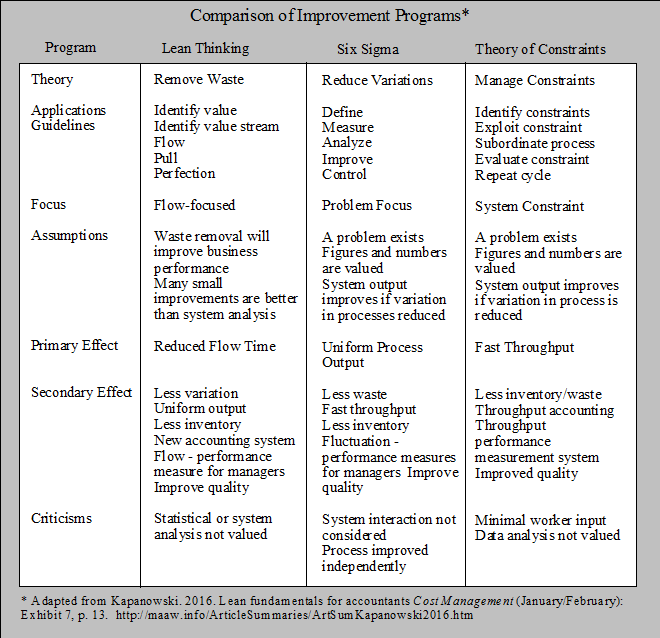
Producing more than customer demand? Implement a pull system.
Producing less than customer demand? Review capacity constraints, remove non-value added work through lead time reduction.
Meeting demand but with long lead times and high overhead? Use 5S, a pull system, lead time reduction, total productive maintenance, safety stock for demand variations, balance the process, reduce batch sizes, and check for errors.
Uneven workloads? Balance the process.6
Too much movement? Use value stream mapping to improve the process flow.
Conclusion
This article provides a fundamental review of lean concepts and tools and a variety of ways accountants can use them to remove waste and improve performance. Although lean concepts and tools were developed in the manufacturing environment, anyone can use lean, anywhere, in any organization.
___________________________________________
Notes:
1 Womack, J. P. and D. T. Jones. 1996. Lean Thinking: Banish Waste and Create Wealth in Your Corporation. New York: Simon & Schuster. p. 15.
2 Womack, J. P., D. T. Jones and D. Roos. 1991. The Machine That Changed the World: The Story of Lean Production. New York: Harper Perennial.
3 Liker, J. 2003. The Toyota Way: 14 Management Principles From The World's Greatest Manufacturer. McGraw-Hill.
4 In his 1993 book The New Economics, Deming referred to this as the Shewhart plan-do-study-act cycle (see the Deming summary below).
5 Goodson's definition includes signage that guides workers to appropriate locations, tools, and tasks, as well as records related to productivity, quality, and maintenance. Goodson describes a rapid plant assessment rating sheet that includes 11 categories for assessing leanness, and a questionnaire that includes 20 yes or no questions that are used to determine if the plant uses best practices in the 11 categories. (see the Goodson summary below).
6 For Goldratt's argument against balancing the plant, see my summary of Goldratt's dice game below.
Related summaries:
Baggaley, B. and B. Maskell. 2003. Value stream management for lean companies, Part I. Journal of Cost Management (March/April): 23-27. (Summary).
Baggaley, B. and B. Maskell. 2003. Value stream management for lean companies, Part II. Journal of Cost Management (May/June): 24-30. (Summary).
Brosnahan, J. P. 2008. Unleash the power of lean accounting. Journal of Accountancy (July): 60-66. (Summary).
Cooper, R. 1996. Activity-based management and the lean enterprise. Journal of Cost Management (Winter): 6-14. (Summary).
Deming, W. E. 1993. The New Economics For Industry, Government & Education. Massachusetts Institute of Technology Center for Advanced Engineering Study. (Summary).
Fullerton, R. R. 2003. Performance measurement and reward systems in JIT and non-JIT firms. Cost Management (November/December): 40-47. (Summary).
Fullerton, R. R. and C. S. McWatters. 2002. The role of performance measures and incentive systems in relation to the degree of JIT implementation. Accounting, Organizations and Society 27(8): 711-735. (Summary).
Goldratt, E. M. 1990. What is this thing called Theory of Constraints. New York: North River Press. (Summary).
Goldratt, E. M. and J. Cox. 1986. The Goal: A Process of Ongoing Improvement. North River Press. (Summary).
Goodson, R. E. 2002. Read a plant - fast. Harvard Business Review (May): 105-113. (Summary).
Imai, M. 1986. Kaizen: The Key To Japan's Competitive Success. New York: McGraw-Hill Publishing Company. (Summary).
Kapanowski, G. 2017. Lean accounting. Cost Management (January/February): 37-41. (Summary).
Maginnis, M. A. and G. Uminger. 2018. Management accounting in a true lean (TPS) environment. Cost Management (January/February): 27-35. (Summary).
Martin, J. R. Not dated. Chapter 8: Just-In-Time, Theory of Constraints, and Activity Based Management Concepts and Techniques. Management Accounting: Concepts, Techniques & Controversial Issues. Management And Accounting Web. Chapter8.htm
Martin, J. R. Not dated. Lean concepts and terms. Management And Accounting Web. LeanConceptsandTermsSummary.htm
Martin, J. R. Not dated. Profit Beyond Measure graphics and notes. Management And Accounting Web. JohnsonBromsGraphicsNotes.htm
Martin, J. R. Not dated. Goldratt's dice game or match bowl experiment. Management And Accounting Web. MatchBowlExperiment.htm
Martin, J. R. Not dated. What is lean accounting? Management And Accounting Web. LeanAccounting.htm
Martin, J. R. Not dated. What is Six Sigma? Management And Accounting Web. SixSigmaSummary.htm
Pickering, M. 2017. Implementing lean management reporting in lean enterprises. Cost Management (January/February): 28-36. (Summary).
Spear, S. and H. K. Bowen. 1999. Decoding the DNA of the Toyota production system. Harvard Business Review (September-October): 97-106. (Summary).
Spear, S. J. 2004. Learning to lead at Toyota. Harvard Business Review (May): 78-86. (Summary).
Staats, B. R. and D. M. Upton. 2011. Lean knowledge work: The "Toyota" principles can also be effective in operations involving judgment and expertise. Harvard Business Review (October): 100-110. (Summary).
Swank, C. K. 2003. The lean service machine. Harvard Business Review (October): 123-129. (Summary).
Toyota Public Affairs Division and Operations Management Consulting Division. 1998. The Toyota Production System: Leaner Manufacturing for a Greener Planet. The Toyota Motor Corporation. (Summary).
Womack, J. P. and D. T. Jones. 1994. From lean production to the lean enterprise. Harvard Business Review (March-April): 93-103. (Summary).
Womack, J. P. and D. T. Jones. 1996. Beyond Toyota: How to root out waste and pursue perfection. Harvard Business Review (September-October): 140-144, 146, 148-152, 154, 156, 158. (Summary).